Regional Outstanding Tree Farmers of the Year: The Boutwell Family of Alabama
What makes them outstanding?
Check out the Boutwell webinar!
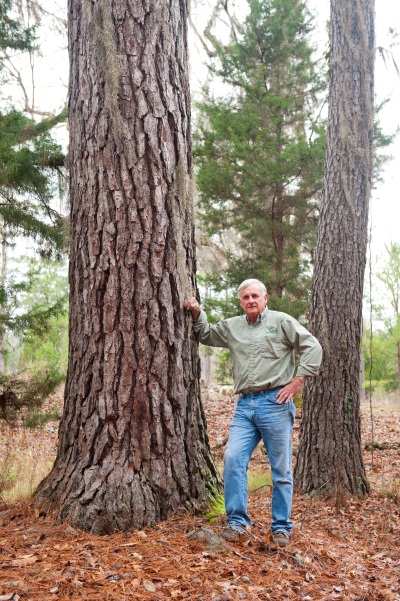
John Boutwell is everyman’s Tree Farmer. Unlike many landowners with over 1,000 contiguous acres, he or his family perform most of the sweat equity on the Tree Farm themselves. He is an astute student of the environment. He seeks out experts, studies on his own, and is always ready to try something new. Even in times of adversity, such as a severe pine beetle infestation and Hurricane Ivan, John used beetle killed timber to build a beautiful cabin and turned hurricane wind- damaged timber into healthy, young forests.
His active participation in the Alabama State Tree Farm Committee fostered his importance of a current management plan and accurate maps. He uses My Land Plan for property stand maps and supplemental information for his management plan. John’s outreach efforts extend far beyond the Tree Farm Committee. He is an active voice for landowners at the state and national level. He has hosted large groups of landowners and Boy Scout Troops. Although he enjoys groups that visit Cedar Creek Plantation, his favorite outreach is one-on-one with children who are fascinated fossil hunting in Cedar Creek and individual landowners who want to learn various management practices.
Through his example, several individuals have purchased land and are on the path to becoming certified Tree Farmers. John best summed up why he is a Tree Farmer in the Alabama Tree Farm’s Green Horizons newsletter: “I am a Tree Farmer. I plant trees, grow trees and sell trees. I’ve got the best job on earth.”
Tree Farmer Story
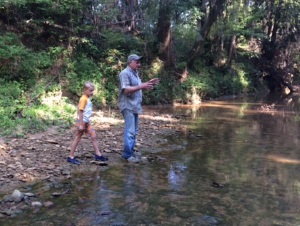
The core of Cedar Cree Plantation Tree Farm is truly family land, and has been for nearly 100 years. John and his sister Peggy’s grandfather, O.L. ‘Boss’ Boutwell, purchased the original 39 acres of the ‘home place’ in 1917 when their father was not even 2 years old. There was a house on the property when it was purchased, and the family continued to live there until 1963. From 1917 through 1951 ‘Boss’purchased 6 additional tracts of land bringing total acreage to about 1,750 acres. ‘Boss’and his son were cattlemen and farmers “ timber and wildlife were secondary. A perimeter fence encompassed the whole place (about 20 miles total), and a cow-calf operation was the main farm enterprise. Corn and hay was grown to support the cattle operation and some cotton was grown as a cash crop.
John’s father worked for the Soil Conservation Service and was interested in other benefits of the land “ timber, wildlife and water". In 1961, their property was inducted into the Tree Farm Program.
John attended Auburn University and graduated with BS and MS degrees in Agricultural Economics in 1973 and 1975. He has enjoyed a long career as the farmer and land manager of 5,000 acres of family land.
John and Peggy’s grandparents
and parents passed away. The cows were
sold, and timber became the primary crop of the land. All this happened over several years, with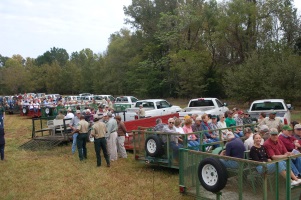 much planning and preparation. John and
his wife Ann purchased 3 adjacent tracts which brought the total acreage of the
Tree Farm to approximately 2,150 acres.
much planning and preparation. John and
his wife Ann purchased 3 adjacent tracts which brought the total acreage of the
Tree Farm to approximately 2,150 acres.
Tree Farming is not without risks and challenges. The Boutwells have lived through two devastating events on their property. In the early 1990’s, they experienced a terrible pine beetle epidemic. Then, in 2004, the 90+ mph winds of Hurricane Ivan destroyed or damaged much of their mature timber. In both instances, the land was replanted. Beetle damaged wood was sawn into lumber and repurposed into a beautiful cabin that is the family recreational centerpiece of the property. Over 1,000 acres were salvaged, and 140 acres were so severely damaged they had to be cleared and replanted after Ivan.
From 2002, John began a commercial hunting operation on the property and wildlife habitat became an important management objective. In 2012, John ceased commercial hunting, and the property was leased to two individuals for hunting and recreation. This move freed him to devote more time to the upkeep of the property and for timber development.
Today, John oversees all of the
management activities on the entire property including 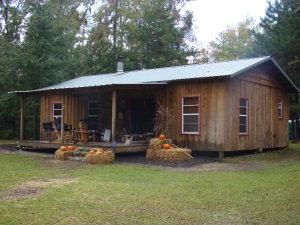 timber sales,
reforestation, timber improvement practices, road maintenance, wildlife
plantings and much more. Other than
plantation planting, occasional mechanical site prep and helicopter spraying,
all management activities are performed by John and his family. His two sons, daughter, wife Ann and sister
Peggy are active participants in decision making and carrying out the
work. Six grandchildren spend
considerable time with John, and are learning invaluable lessons in land
ethics, sustainable forest and wildlife management and enjoying themselves
without electronic devices.
timber sales,
reforestation, timber improvement practices, road maintenance, wildlife
plantings and much more. Other than
plantation planting, occasional mechanical site prep and helicopter spraying,
all management activities are performed by John and his family. His two sons, daughter, wife Ann and sister
Peggy are active participants in decision making and carrying out the
work. Six grandchildren spend
considerable time with John, and are learning invaluable lessons in land
ethics, sustainable forest and wildlife management and enjoying themselves
without electronic devices.
John and his family are very
willing to reach out to others and show them what hard work, and sustainable
management practices can produce on family forest land. They have hosted groups of landowners for
tours and Boy Scouts for Camporees. John
is also known for his willingness to take time and show and tell interested
adults about his property one-on-one.
John has written several articles for the Alabama Forestry Association’s
magazine on his views of being a Tree Farmer and value in the use of My Land
Plan. He is also sought out by groups to
work on political policies that support programs that positively impact healthy
forests, forest industry, and forestry programs. John and his wife 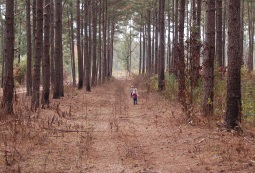 Ann have
participated in three National Tree Farm Conventions (2010, 2013 and 2014), and
the Aldo Leopold Foundation’s Land Ethic Workshop.
Ann have
participated in three National Tree Farm Conventions (2010, 2013 and 2014), and
the Aldo Leopold Foundation’s Land Ethic Workshop.
Family use of the Tree Farm centers at the cabin which John and his family built in 2002 from beetle damaged trees. Cedar Creek and many other streams on the land are also a focal point. The family spends many weekends at Cedar Creek Plantation, and especially enjoys celebrating family Christmas at the cabin every year. John and his sons enjoy deer, quail, and turkey hunting. The grandchildren just enjoy being there and playing in the water. It’s a perfect place to get away “ no power lines, no TV, and no phone service". Their friends ask them when they are coming out to civilization, and they respond “We are in civilization. Where are you?”
Time at the property also means time for work. The family plants orchards and wild flowers, and cleans up the area around the cabin. If orchard trees are planted, the grand kids’ job is to spit in the hole so the trees will grow!
Peggy’s family enjoys camping out on the land and riding ATV’s over the many trails. Peggy stays in the cabin!
As complex as the history is, this land has a bright future. Because of the family’s love of and commitment to this land, and their desire for the land to remain intact for future generations, the ownership of John and Ann’s land has been placed in a family partnership and is being transferred to their three children. Ann and John are confident the land is in good hands. Their son Andrew has degrees in forestry and business management and can handle the business decisions. Their son Thomas is qualified to operate and service all the machinery needed to maintain the farm, and can handle the wildlife management decisions. Their daughter Katie, an ordained Methodist minister, will pray for her brothers and put the fear of God in them if needed!
As the 2012 Alabama Tree Farmers of the Year, John and Ann, Peggy and their families are shining examples of who Tree Farmers are, and would represent ATFS well as National Tree Farmers of the Year.
Wood
Timber production is the primary objective of Cedar Creek Plantation. The soils are diverse both lower coastal plain and black belt soils are present. John’s key to timber management and species selection lies in recognizing and respecting the difference in soils and their productivity. In general, pine is grown on the ridges and hardwood in the bottoms. During the pine beetle infestation, 100 acres were clearcut and replanted the following year. Most harvests made today are a result of understocked stands due to Hurricane Ivan. One of the main challenges the Boutwells face is finding logging crews willing to perform select cuts on small areas. Invasive plants are also a challenge, and John chemically controls them annually as they often resprout after burning.
Water
Fresh, clear, running water is one of the strongest features on this property. Cedar Creek runs for 3.2 miles, and tributary streams coming into the Cedar Creek travel another 8.9 miles through this land. All these streams have bottoms of predominantly limestone rock and sand, and run crystal clear except for periods of heavy rains. Children, grandchildren and friends all enjoy playing and fishing in the creek and streams. The area also abounds in marine fossils from approximately 65 million years ago when this area was covered by the sea, and they are easily found on the rock shoals of the creek and some streams.
All logging crews adhere to harvest according to Alabama’s Best Management Practices (BMPs) to protect the streamside management zones (SMZs) and minimize soil runoff into the streams. There are a total of 172 acres of SMZs on this Tree Farm. A combination of culvert pipes, bridges, and stabilized bank crossings (in combination with the natural stone bottoms) give good access for roads on the land while protecting the streams.
In 2008, approximately 7 acres were planted with 2,000 oak trees of five different species to create a riparian buffer zone along Cedar Creek and two of its main tributaries. In addition to stabilizing the soil, these trees will provide valuable soft mast and bedding areas for wildlife. The oaks are now big enough to be mowed and cross-mowed to control unwanted competition.
There are also two ponds (2 acres) on the property which provide bass and bream fishing for family and friends.
Wildlife including threatened and endangered species
Wildlife is plentiful and varied on this land, because much effort is expended to make them feel welcome. About 75 acres of wildlife openings are devoted to winter and summer food plots. Winter plots are planted in small grains, clovers and brassicas, while summer plots contain corn, milo or soybeans. 11 hard mast bearing orchards provide food in the fall and winter, and a soft mast orchard of apple and pear trees bears fruit in late summer. Supplemental protein feed is provided for the deer herd in mid-summer.
Delayed spring cutting in the hay fields permits hen turkeys to successfully nest, and no cutting in August protects new born fawns. Open fields of native grass, low density longleaf plantings, and liberal controlled burns provide good habitat for quail. Mature hardwoods are a favorite of squirrels, and briar patches are plentiful for rabbits.
Non-game species aren’t overlooked. Hollow trees are used by bats, and houses are provided for blue birds and wrens. Plentiful dead snags are available for woodpeckers. Bobcats, foxes and otters are occasionally seen. Black bears were sighted near the property in 2014. John has even had two sightings of what he believes is a family of jagurundi.
The other ‘non-game’ species is the resident cabin deer herd. 12 to 24 does and fawns feel safe around the cabin and visit each afternoon during the winter for a snack of shelled corn. They also enjoy azaleas and summer garden plantings.
No threatened and endangered species are known to be present per NHP’s list for Butler County; however, 172 acres of SMZs protect any aquatic associated species that may be present, and unique limestone rock/cedar areas that are home to many wildflowers are left undisturbed. Red Cockaded Woodpecker and Gopher Tortoise habitat is present, but none have been observed.
Recreation
Recreation and aesthetics abound on Cedar Creek Plantation. A cabin was built by John’s family of lumber from pine beetle damaged trees in 2002. It provides a place for numerous family gatherings, culminating at Christmas each year with a cedar Christmas tree harvested from the land. ‘No-cut’ areas near the cabin to preserve the memory of ‘big timber’ of years gone by. Walking trails that radiate from the cabin and 15 miles of interior roads provide plenty of hiking opportunities. Cedar Creek and its tributaries provide fishing, playing and fossil hunting.
Areas have been identified, protected, and enhanced to show off native wildflowers. Wildflower enthusiasts have toured these sites. Some sample specimens have been transplanted to the cabin area.
Live oaks have been planted beside the road north of the creek to honor one of the grandchildren. This will provide a beautiful drive in addition to valuable soft mast for wildlife, and a link from the present generation to the future.
One invasive species which affects recreation on the land is the fire ant. They arrived in Alabama from South America around 1918, but are now well established all over. John realizes he can’t eradicate them, but he constantly treats mounds around the cabin, barns, and orchards to lessen the chance of anyone being bitten.
In the 1800’s this land was the site of a thriving community with settlers living on the hills and working in the bottoms. John has located 13 pre-1800 house sites on the hills surrounding the creek bottoms. In addition, near the creek are the site of a cotton gin, store and 2.4 miles of railroad bed from the same period. An extremely successful cedar bucket factory is suspected on but not yet positively located on this land. These sites are identified on My Land Plan.


